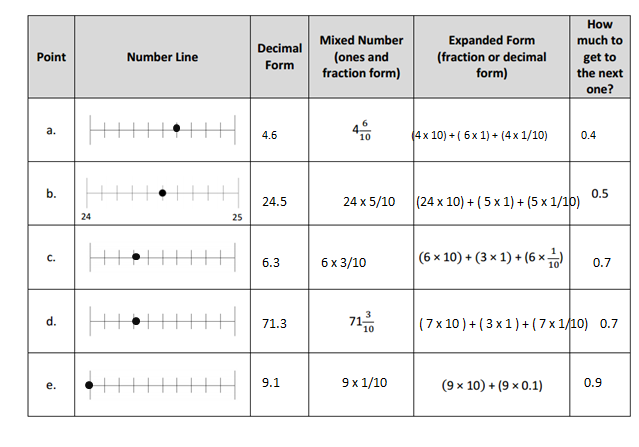Engage NY Eureka Math 4th Grade Module 6 Lesson 3 Answer Key
Eureka Math Grade 4 Module 6 Lesson 3 Problem Set Answer Key
Question 1.
Circle groups of tenths to make as many ones as possible.
a. How many tenths in all?
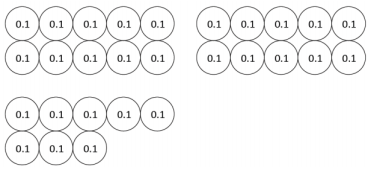
There are ____2_____ tenths.
Write and draw the same number using ones and tenths.
Decimal Form: ____2.8____
How much more is needed to get to 3? ____2 tenths_____
Answer:
There are 3 tenths.
decimal form = 1.8.
the more is needed to get to 3 = 2 tenths.
Explanation:
In the above-given question,
given that,
There are 3 tenths.
decimal form = 1.8.
the more is needed to get to 3 = 2 tenths.
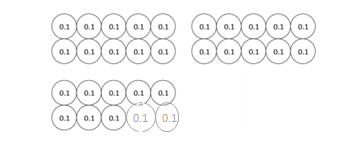
b. How many tenths in all?
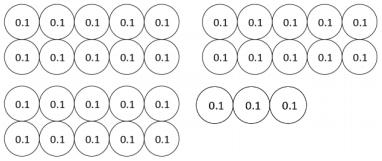
There are ___3______ tenths.
Write and draw the same number using ones and tenths.
Decimal Form: ___3.3______
How much more is needed to get to 4? __7 tenths_______
Answer:
There are 3 tenths.
decimal form = 3.3.
the more is needed to get to 4 = 7 tenths.
Explanation:
In the above-given question,
given that,
There are 3 tenths.
decimal form = 3.3.
the more is needed to get to 4 = 7 tenths.
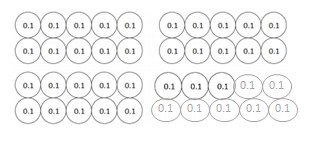
Question 2.
Draw disks to represent each number using tens, ones, and tenths. Then, show the expanded form of the number in fraction form and decimal form as shown. The first one has been completed for you.
a. 4 tens 2 ones 6 tenths

Fraction Expanded Form
(4 × 10) + (2 × 1) + (6 × \(\frac{1}{10}\)) = 42\(\frac{6}{10}\)
Decimal Expanded Form
(4 × 10) + (2 × 1) + (6 × 0.1) = 42.6
b. 1 ten 7 ones 5 tenths
Answer:
17.5
Explanation:
In the above-given question,
given that,
Fraction Expanded Form
(1 × 10) + (7 × 1) + (5 × \(\frac{1}{10}\)) = 17\(\frac{5}{10}\)
Decimal Expanded Form
(1 × 10) + (7 × 1) + (1 × 0.5) = 17.5.

c. 2 tens 3 ones 2 tenths
Answer:
23.2
Explanation:
In the above-given question,
given that,
Fraction Expanded Form
(2 × 10) + (3 × 1) + (2 × \(\frac{1}{10}\)) = 23\(\frac{2}{10}\)
Decimal Expanded Form
(2 × 10) + (3 × 1) + (1 × 0.2) = 23.2.
20 +3 + 0.2 = 23.2

d. 7 tens 4 ones 7 tenths
Answer:
74.7
Explanation:
In the above-given question,
given that,
Fraction Expanded Form
(7 × 10) + (4 × 1) + (7 × \(\frac{1}{10}\)) = 74\(\frac{7}{10}\)
Decimal Expanded Form
(7 × 10) + (4 × 1) + (1 × 0.7) = 74.7.
70 + 4 + 0.7 = 74.7

Question 3.
Complete the chart.
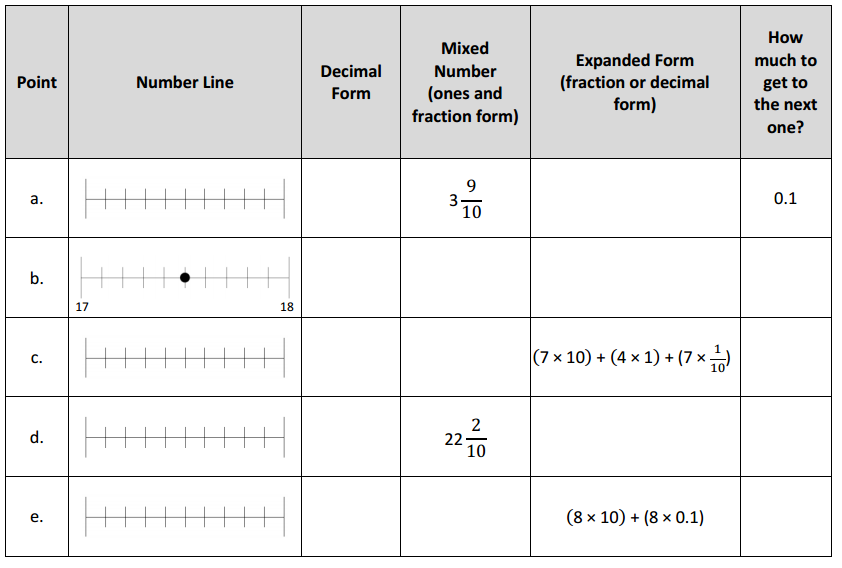
Answer:
a.decimal form = 3.9.
mixed number = 3(9/10).
expanded form = (3 x 10) + (9 x 1) + (3 x 1/10).
how much to get to the next one = 0.1.
Explanation:
In the above-given question,
given that,
decimal form = 3.9.
mixed number = 3(9/10).
expanded form = (3 x 10) + (9 x 1) + (3 x 1/10).
how much to get to the next one = 0.1.
Answer:
b.decimal form = 17.5.
mixed number = 17(5/10).
expanded form = (17 x 10) + (5 x 1) + (17 x 1/10).
how much to get to the next one = 0.5.
Explanation:
In the above-given question,
given that,
decimal form = 17.5.
mixed number = 17(5/10).
expanded form = (17 x 10) + (5 x 1) + (17 x 1/10).
how much to get to the next one = 0.5.
Answer:
c.decimal form = 7.4.
mixed number = 7(4/10).
expanded form = (7 x 10) + (4 x 1) + (7 x 1/10).
how much to get to the next one = 0.6.
Explanation:
In the above-given question,
given that,
decimal form = 7.4.
mixed number = 7(4/10).
expanded form = (7 x 10) + (4 x 1) + (7 x 1/10).
how much to get to the next one = 0.6.
Answer:
d.decimal form = 22.2.
mixed number = 22(2/10).
expanded form = (22 x 10) + (2 x 1) + (22 x 1/10).
how much to get to the next one = 0.8.
Explanation:
In the above-given question,
given that,
decimal form = 22.2.
mixed number = 22(2/10).
expanded form = (22 x 10) + (2 x 1) + (22 x 1/10).
how much to get to the next one = 0.8.
Answer:
e.decimal form = 8.1.
mixed number = 8(1/10).
expanded form = (8 x 10) + (1 x 1) + (8 x 1/10).
how much to get to the next one = 8.1.
Explanation:
In the above-given question,
given that,
decimal form = 8.1.
mixed number = 8(1/10).
expanded form = (8 x 10) + (1 x 1) + (8 x 1/10).
how much to get to the next one = 8.1.
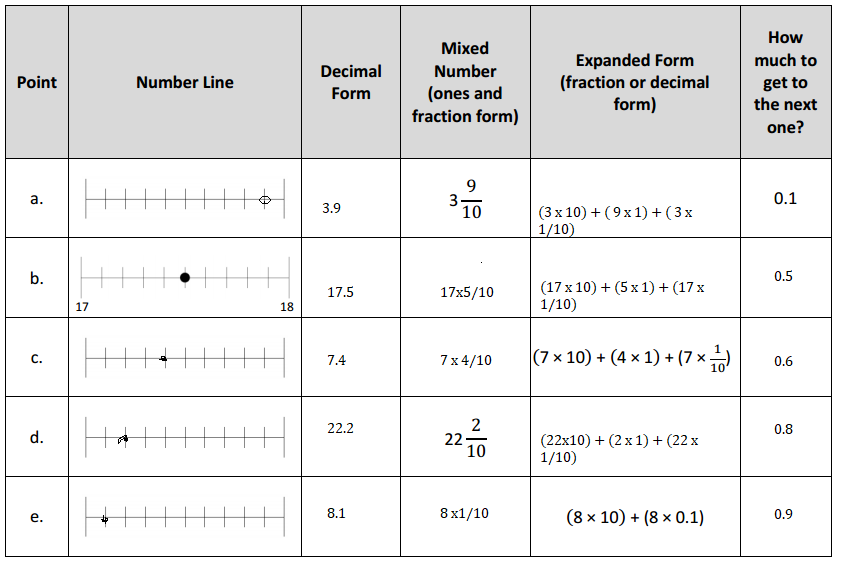
Eureka Math Grade 4 Module 6 Lesson 3 Exit Ticket Answer Key
Question 1.
Circle groups of tenths to make as many ones as possible.
How many tenths in all?

There are ____1_____ tenths.
Write and draw the same number using ones and tenths.
Decimal Form: ___1.8______
How much more is needed to get to 2? ___2 tenths______
Answer:
There is 1 tenth.
decimal form = 1.8.
the more is needed to get to 2 = 2 tenths.
Explanation:
In the above-given question,
given that,
There is 1 tenth.
decimal form = 1.8.
the more is needed to get to 2 = 2 tenths.

Question 2.
Complete the chart.
Answer:
a.decimal form = 12.9.
mixed number = 12(9/10).
expanded form = (12 x 10) + (9 x 1) + (12 x 1/10).
how much to get to the next one = 0.1.
Explanation:
In the above-given question,
given that,
decimal form = 12.9.
mixed number = 12(9/10).
expanded form = (12 x 10) + (9 x 1) + (12 x 1/10).
how much to get to the next one = 0.1.
Answer:
b.decimal form = 70.7.
mixed number = 70(7/10).
expanded form = (70 x 10) + (7 x 1) + (70 x 1/10).
how much to get to the next one = 0.3.
Explanation:
In the above-given question,
given that,
decimal form = 70.7.
mixed number = 70(7/10).
expanded form = (70 x 10) + (7 x 1) + (70 x 1/10).
how much to get to the next one = 0.3.
Eureka Math Grade 4 Module 6 Lesson 3 Homework Answer Key
Question 1.
Circle groups of tenths to make as many ones as possible.
a. How many tenths in all?

There are ____1_____ tenths.
Write and draw the same number using ones and tenths.
Decimal Form: _____1.4____
How much more is needed to get to 2? ___6 tenths_____
Answer:
There is 1 tenth.
decimal form = 1.4.
the more is needed to get to 2 = 6 tenths.

Explanation:
In the above-given question,
given that,
There is 1 tenth.
decimal form = 1.4.
the more is needed to get to 2 = 6 tenths.
b. How many tenths in all?

There are ____2_____ tenths.
Write and draw the same number using ones and tenths.
Decimal Form: ____2.5_____
How much more is needed to get to 3? __5 tenths_____
Answer:
There are 2 tenths.
decimal form = 2.5.
the more is needed to get to 3 = 5 tenths.
Explanation:
In the above-given question,
given that,
There are 2 tenths.
decimal form = 2.5.
the more is needed to get to 3 = 5 tenths.

Question 2.
Draw disks to represent each number using tens, ones, and tenths. Then, show the expanded form of the number in fraction form and decimal form as shown. The first one has been completed for you.
a. 3 tens 4 ones 3 tenths

Fraction Expanded Form
(3 × 10)+ (4 × 1) + (3 × \(\frac{1}{10}\)) = 34\(\frac{3}{10}\)
Decimal Expanded Form
(3 × 10) + (4 × 1) + (3 × 0.1) = 34.3
Answer:
34.3
Explanation:
In the above-given question,
given that,
Fraction Expanded Form
(3 × 10) + (4 × 1) + (3 × \(\frac{1}{10}\)) = 34\(\frac{3}{10}\)
Decimal Expanded Form
(3 × 10) + (4 × 1) + (3 × 0.1) = 34.3.
30 + 4 + 0.3 = 34.3
b. 5 tens 3 ones 7 tenths
Answer:
53.7
Explanation:
In the above-given question,
given that,
Fraction Expanded Form
(5 × 10) + (3 × 1) + (7 × \(\frac{1}{10}\)) = 534\(\frac{7}{10}\)
Decimal Expanded Form
(5 × 10) + (3 × 1) + (1 × 0.7) = 53.7.
50 + 3 + 0.7 = 53.7

c. 3 tens 2 ones 3 tenths
Answer:
32.3
Explanation:
In the above-given question,
given that,
Fraction Expanded Form
(3 × 10) + (2 × 1) + (3 × \(\frac{1}{10}\)) = 32\(\frac{3}{10}\)
Decimal Expanded Form
(3 × 10) + (2 × 1) + (1 × 0.3) = 32.3.
30 + 2 + 0.3 = 32.3

d. 8 tens 4 ones 8 tenths
Answer:
84.8
Explanation:
In the above-given question,
given that,
Fraction Expanded Form
(8 × 10) + (4 × 1) + (8 × \(\frac{1}{10}\)) = 84\(\frac{8}{10}\)
Decimal Expanded Form
(8 × 10) + (4 × 1) + (1 × 0.8) = 84.8.
80 + 4 + 0.8 = 84.8

Question 3.
Complete the chart.
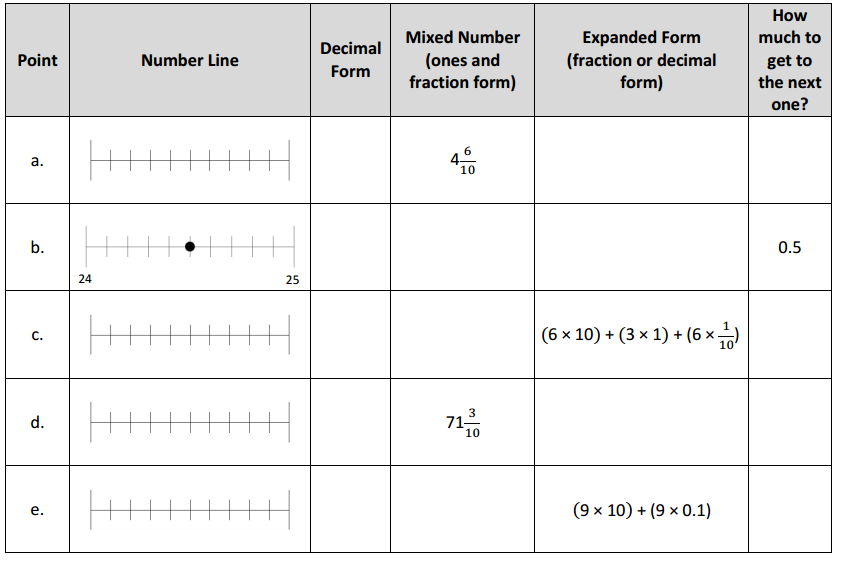
Answer:
a.decimal form = 4.6.
mixed number = 4(6/10).
expanded form = (4 x 10) + (6 x 1) + (4 x 1/10).
how much to get to the next one = 0.4.
Explanation:
In the above-given question,
given that,
decimal form = 4.6.
mixed number = 4(6/10).
expanded form = (4 x 10) + (6 x 1) + (4 x 1/10).
how much to get to the next one = 0.4.
Answer:
b.decimal form = 24.5.
mixed number = 24(5/10).
expanded form = (24 x 10) + (5 x 1) + (24 x 1/10).
how much to get to the next one = 0.5.
Explanation:
In the above-given question,
given that,
decimal form = 24.5.
mixed number = 24(5/10).
expanded form = (24 x 10) + (5 x 1) + (24 x 1/10).
how much to get to the next one = 0.5.
Answer:
c.decimal form = 6.3.
mixed number = 6(3/10).
expanded form = (6 x 10) + (3 x 1) + (6 x 1/10).
how much to get to the next one = 0.7.
Explanation:
In the above-given question,
given that,
decimal form = 6.3.
mixed number = 6(3/10).
expanded form = (6 x 10) + (3 x 1) + (6 x 1/10).
how much to get to the next one = 0.7.
Answer:
d.decimal form = 71.3.
mixed number = 71(3/10).
expanded form = (71 x 10) + (3 x 1) + (71 x 1/10).
how much to get to the next one = 0.7.
Explanation:
In the above-given question,
given that,
decimal form = 71.3.
mixed number = 71(3/10).
expanded form = (71 x 10) + (3 x 1) + (71 x 1/10).
how much to get to the next one = 0.7.
Answer:
e.decimal form = 9.9.
mixed number = 9(9/10).
expanded form = (9 x 10) + (9 x 1) + (9 x 1/10).
how much to get to the next one = 0.1.
Explanation:
In the above-given question,
given that,
decimal form = 9.9.
mixed number = 9(9/10).
expanded form = (9 x 10) + (9 x 1) + (9 x 1/10).
how much to get to the next one = 0.1.
